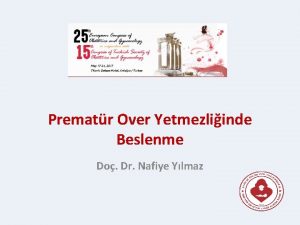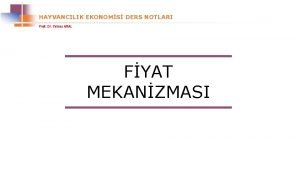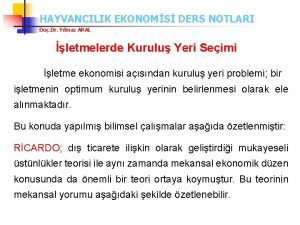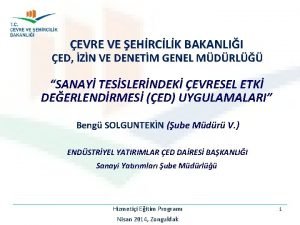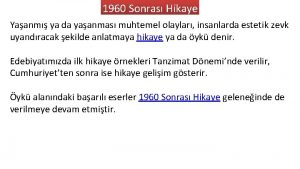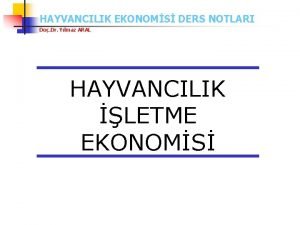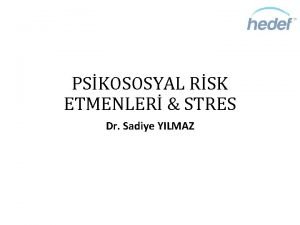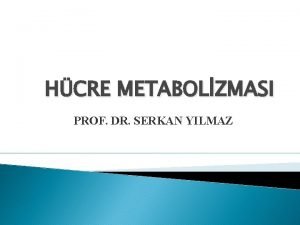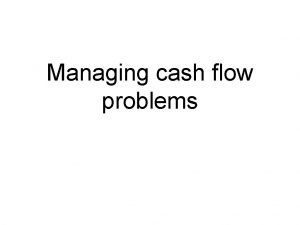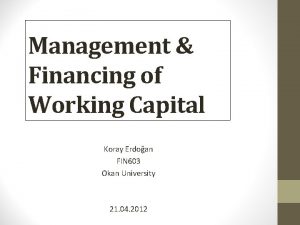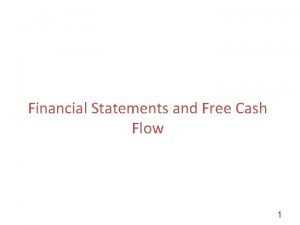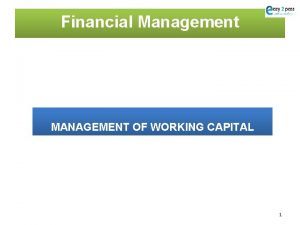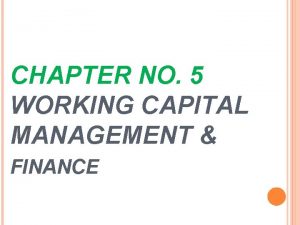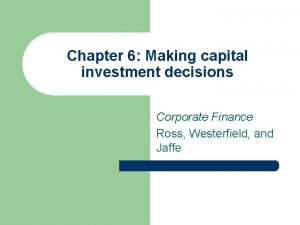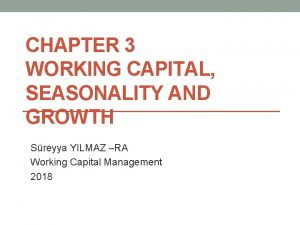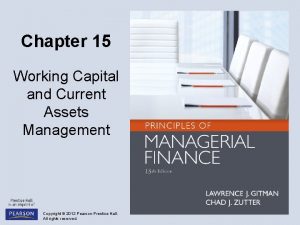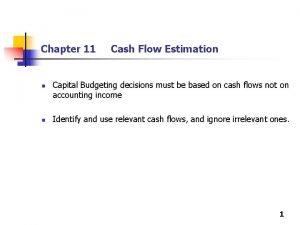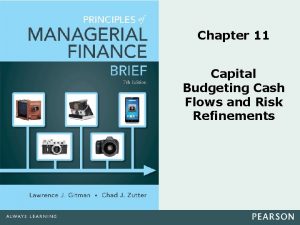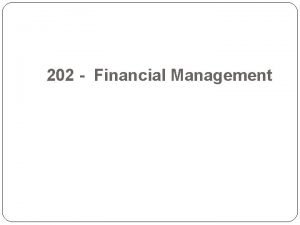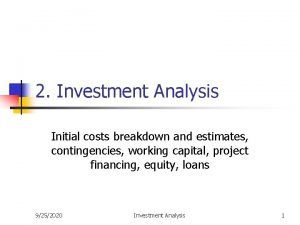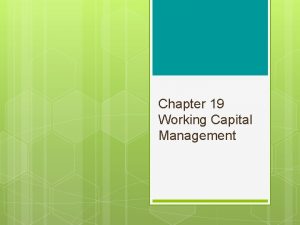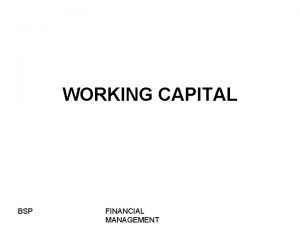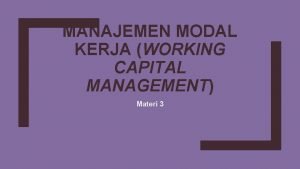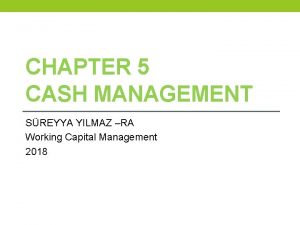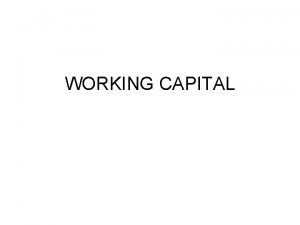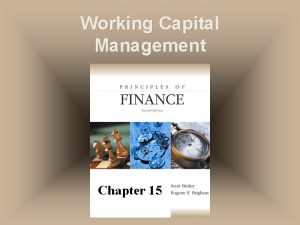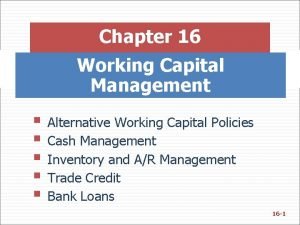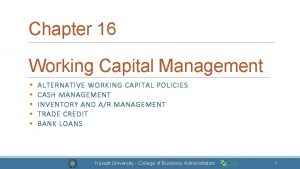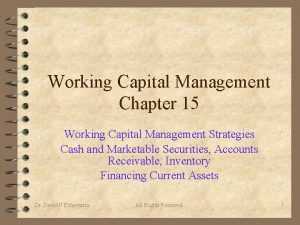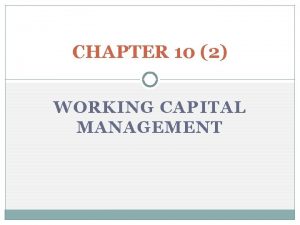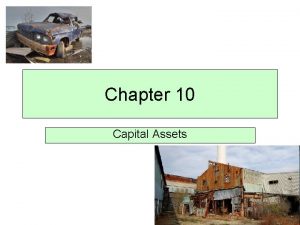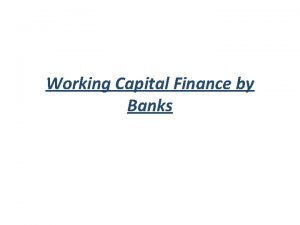CHAPTER 2 WORKING CAPITAL SREYYA YILMAZ RA Working






















































- Slides: 54

CHAPTER 2 WORKING CAPITAL SÜREYYA YILMAZ –RA Working Capital Management 2018

What is the working capital?

• Working capital is usually defined as: Working Capital= Current Assets- Current Liabilities

• We can obtain an equivalent estimate of working capital by solving in the opposite direction, by calculating working capital as: Working Capital= Capital-Fixed Assets

What does firm’s operating investment include? • Firm’s inventories(raw materials or final goods) • Trade receivables • Min. level of liquidity That is? ? ?

How does this investment finance? • The firm’s short-term operating liabilities or • The credits provided to the firm from suppliers, employees and the tax authority.

What happen, if the firms excess the operating investment? • Financial capital needed to sustain the operation of the firm after taking into account its short-term operating liabilities. • Is referred to as its financial needs for operation(FNOs).

• FNOs are defined as: Financial Needs For Operation= (Current Assets) – (Short Term Operating Liabilities)

Could you explain?

• FNOs can be considered as a short-term concept, since both current assets and short term operating liabilities vary with the firm’s activity level.

• FNOs represent the net operating investment necessary to run the business, it is critical for a firm to find potential sources to finance this need. • Two table show us; FNOs wwith working capital and thus has turned to the financial markets to close the gap between needs and sorces of funds.

What is your inference? • We can say that the firm generates financial needs for operation. Working capital is one of the sources of funds the firm can use to finance that need; the balance will be financed using short-term financial debt.

• Under this framework, it is clear that the amount of working capital a firm decides to use is a strategic decision, as it determines how much of the FNOs to finance with long-term capital and how much to finance with short-term financial debt.

A Simple Example • Imagine that John and Mary decide to start a new business, say, a pasta company. John will be in charge of marketing and sales, while Mary will be in charge of operations. Each of them buys 50% of the newly issued shares of the startup company for $100, 000. The balance sheet of the firm after the company’s first day is as depicted in Figure 1.

• Before production can begin, the firm needs to acquire property in which to install a production facility. The firm also needs to obtain the necessary production and packaging equipment. We assume that the company pays $50, 000 for the property and $150, 000 for the equipment, financing these initial investments with cash obtained from theoriginal equity issue.

• On the first day of operation, John obtains the company’s first order: one of the largest grocery stores in town has placed an order for $10, 000 in pasta. Since the firm will need to pay $5, 000 for supplies and $4, 000 for production costs (mostly to employees), the net profit of the sale, after deducting all the appropriate costs, will be $1, 000. Mary contacts the supplier, buys the appropriate goods, and starts manufacturing the pasta. The supplier gives the new firm 60 days to pay the invoice, and employees will need to be paid in 30 days. However, John told Mary that the customer will pay the invoice in the 60 days.


• Notice that the firm’s equity has increased from $200, 000 to $201, 000. The difference represents the $1, 000 profit arising from the sale.

• At this point, it is useful to freeze the firm’s operations and assume that nothing new happens so that we can analyze the financial effects of the first sale without receiving new information that might complicate our understanding of the dynamics at hand. After 30 days, employees need to be paid.


• Note that the short-term financing provided by employees has now disappeared, as they need to be paid. But the firm faces a cash constraint: while it needs $4, 000 to compensate employees, it does not have any liquid assets with which to make these payments. • This cash constraint highlights the importance of the different maturities of assets and liabilities. In 30 more days the company would be able to resolve this issue, as that is when the customer will pay the firm the $10, 000 owed. Meanwhile, however, the company needs $4, 000 to stay alive until collection day.

We should remember all of steps to set up investment! • Invest to PPE ( plant, property and equipment) (The company didn’t have any operating investment so working capital was equal to zero) • With the first sale of pasta, the firm needed to make a second investment as the grocery store buying their pasta needed financing of 60 -day payment terms. The payment of the 10, 000$. (This operational investment was initially financed by suppliers ($5, 000), employees ($4, 000), and the firm’s profit share of the transaction ($1, 000)).

• At that point in time, the firm’s FNOs amounted to $1, 000 (Current assets [$10, 000] – Short-term operating liabilities [$5, 000 + $4, 000]) • The firm’s working capital was also equal to $1, 000 (Current assets [$10, 000] – Current liabilities [$9, 000])

• After 30 days, however, the situation had changed; since the payment to employees became due, some of the short -term operating liabilities disappeared, • The FNOs increased from $1, 000 to $5, 000 (current assets [$10, 000] – suppliers [$5, 000]), and working capital remained unchanged at $1, 000.

• This caused a loss of balance between the firm’s FNOs and working capital, requiring that the company find an additional source of financing to pay the $4, 000 owed to employees.

What should the firm do? • They can call a bank and ask for short-term financial debt. • Alternatively, they can raise additional long-term capital, in the form of either long-term debt (by negotiating bank debt or issuing bonds) or equity (by issuing more equity). • If they decide to raise more long-term capital, they would affect the level of working capital; in contrast, if they decide to issue short-term debt, working capital would remain unchanged. • As a third option, the firm could try to obtain extra financing from suppliers and employees, which would have the effect of reducing the firm’s FNOs.

DETERMINANTS OF FINANCIAL NEEDS FOR OPERATION • Recall that FNOs equal current assets minus short-term operating liabilities. • This definition implies that any increase in current assets and/or decrease in short-term operating liabilities will result in an increase in a firm’s FNOs; conversely, any decrease in current assets and/or increase in short-term operating liabilities will produce the opposite effect. • Current assets mainly consist of customers’ trade receivables, inventory, and cash holdings, while shortterm operating liabilities consist of credits from suppliers, employees, and the tax authority.

ACCOUNT RECEIVABLES • Companies often allow customers a specified number of days to pay their invoices. The use of such credits generates trade receivables, also known as account receivables. • More specifically, goods or services delivered to customers on credit will increase the receivables balance, and payments subsequently received from customers will decrease this balance.

• Trade receivables thus show the balance of the current account that customers have with the firm on the balance date. On average, the balance of a given customer’s current account is obtained by multiplying the daily volume of sales to that customer times the number of days the customer is allowed to take to pay the bill.

• If we extend this analysis to the whole firm total account receivables is equal to the firm’s average daily sales (total annual sales / 360) times the average collection period the firm sets across customers. More formally: Account Receivables = Daily Sales. XCollection Period.

How can you comment this formula? • This equation shows that a firm’s receivables are directly related to the level of the firm’s sales and the number of days the firm allows its customers to take to pay their invoices.

What is the implies? • This implies that; • (1) as a firm grows in terms of sales, either because of sustained growth or seasonal growth, FNOs will increase, • (2) as the firm increases the collection period offered to its customers, FNOs will again increase.

• Before moving on, we note that daily sales are a function of both sales volume and price. Therefore, we can say that: Account Receivables = f (Sales Volume, Sales Price, Days Credit to Customers)

INVENTORY • A firm’s inventory is the necessary investment that the firm needs to make to ensure the normal operation of the business and a certain level of customer service. • Some firms, because of their operating or commercial structure, need to make a large investment in inventory, while others can operate with a lower level of inventory.

• Usually, we can divide a firm’s inventory into raw materials and finished goods. When a company buys a unit of a given input, this is recorded in inventory at the purchase price, while when it produces a unit of a given product and stores it, this item is recorded in inventory according to its cost of goods sold.

• Firms usually define an optimal number of days to keep each kind of good in their inventory. The level of a firm’s inventory at any point in time therefore reflects the total value of the goods kept by the firm, as measured by the goods’ appropriate cost.

• On average, a firm’s inventory balance can be calculated as follows: Inventory = Daily Cost of Goods X Days in Inventory

• This simple expression is useful in illustrating that a firm’s inventory balance is a direct function of the cost of the goods held in inventory and the number of days that the goods are held in inventory. This implies that as either of these factors increases, FNOs also increase.

• Similar to the case of receivables, we know that the daily cost of the goods held in inventory is a function of sales volume and the cost of buying or producing each good in question. Thus, we can say: Inventory = f (Sales Volume, Cost of Goods, Day’s in Inventory)

CASH HOLDINGS • Cash holdings are similar to inventory in that, to “keep the company going, ” management needs to be sure that the firm has a certain level of cash available to satisfy the cash requirements that arise during normal operations.

Why? • Because the need for cash is usually associated with the firm’s activity level and cash cycle, different firms are likely to establish different levels of cash holdings.

• In general terms, we can define cash holdings as a function of the firm’s activity level, administrative efficiency, and production and cost structure. More formally: Cash Holdings = f (Activity Level , Efficiency, Production, Cost Structure)

ACCOUNT PAYABLES • We characterized customers’ trade receivables; suppliers’ trade credit works analogously. Suppliers sell their products to the firm and allow a certain amount of time before payment is due. • Thus, account payables increases every time the firm receives a new shipment of goods and decreases every time it makes the corresponding payment.

• We extend this analysis to the whole firm, we can define account payables as the firm’s average daily purchases times its average number of days of credit. More formally: Account Payables = Daily Purchases X Days Credit from Suppliers • Obviously, purchases are driven by sales.

• The determinants of suppliers’ trade credit are thus sales volume, the price of raw materials, and days of credit: Account Payables = f (Units Bought, Price of the Goods, Days of Credit) • As we mentioned, credit from employees and the tax authority add to the spontaneous resources of a firm, reducing the financial needs for operation.

What is the summarize? • To summarize, any increase in receivables, inventory, or cash holdings or any decrease in credit from suppliers, employees, or the tax authority will increase FNOs (and vice versa). • It is worth pointing out, however, that most of these determinants are not always under the firm’s control.

• We cannot overstate the importance of the link between a firm’s competitive position and ability to affect the level of FNOs to the dynamics of working capital management. • Frequently, errors in corporate strategic and financial planning can be traced to the failure of management to recognize the link between strategy and working capital management.

DETERMINANTS OF WORKING CAPITAL • In contrast to FNOs, a firm strategically sets its level of working capital. To maintain the desired level, the firm will need to adjust its capital structure over time.

• Notice that the working capital decision implies a choice with respect to the firm’s financing: • How much of the firm’s current assets should the firm finance with long-term capital? • A great deal of a treasurer’s daily activity and a firm’s future profitability is affected by this decision.

• As we discussed earlier, a firm increases (decreases) its working capital when it increases (decreases) its level of equity or long-term debt and/ or when it decreases (increases) its level of fixed assets. • Therefore, it is crucial to notice that decisions regarding fixed assets and long-term debt and equity are decisions over how to set the appropriate level of working capital.

• Consequently, working capital should not be considered simply a short-term decision, nor should it be revised or determined solely on a short-term, or operating, basis.

CONCLUSION • We showed that in order to correctly understand the mechanics and implications of a firm’s working capital, we need to take into account a firm’s financial needs for operation, or FNOs. • A firm’s FNOs are the level of operating investment needed for the company to operate its business. This investment can be financed using working capital and/or short-term financial debt.

• Because a firm’s working capital and FNOs are interconnected, use of only one of them in isolation will usually lead the manager astray. • Indeed, decisions regarding the mix of working capital and short-term financial debt are among the firm’s important strategic, or long-term, business decisions. In the next chapter, we look at how these should be combined along a firm’s dynamic path.

NEXT WEEK • Homework! Write an example about FNOs and Working Capital. • Read 3 Chapter Thank you for attendance Lovely week
 Working capital management introduction
Working capital management introduction Meral yılmaz öğretmen
Meral yılmaz öğretmen Gül kaleli yılmaz
Gül kaleli yılmaz Dr canan yılmaz
Dr canan yılmaz Fikriye yılmaz
Fikriye yılmaz Prof dr nafiye yılmaz
Prof dr nafiye yılmaz Zerrin yılmaz
Zerrin yılmaz Prof. dr. yılmaz aral
Prof. dr. yılmaz aral Hayvancılık ekonomisi
Hayvancılık ekonomisi Emriye yilmaz mollasalihoğlu
Emriye yilmaz mollasalihoğlu Dr erman yılmaz
Dr erman yılmaz 1960 sonrası hikaye örnekleri
1960 sonrası hikaye örnekleri Aysel ersoy yılmaz
Aysel ersoy yılmaz Dr ceylan yilmaz
Dr ceylan yilmaz Yılmaz çolpan
Yılmaz çolpan Mehmet emre yılmaz
Mehmet emre yılmaz Blgen
Blgen Prof. dr. meltem yılmaz
Prof. dr. meltem yılmaz Prof. dr. meltem yılmaz
Prof. dr. meltem yılmaz Hipofosfatemi
Hipofosfatemi Yılmaz aral
Yılmaz aral Sadiye yilmaz
Sadiye yilmaz Paraksiyel mezoderm
Paraksiyel mezoderm Paraksiyal mezoderm nedir
Paraksiyal mezoderm nedir Krebs evresi
Krebs evresi Difference between capital reserve and reserve capital
Difference between capital reserve and reserve capital Multinational capital structure
Multinational capital structure Difference between capital reserve and reserve capital
Difference between capital reserve and reserve capital Basle ii
Basle ii Regulatory capital vs economic capital
Regulatory capital vs economic capital Constant and variable capital
Constant and variable capital Multinational cost of capital and capital structure
Multinational cost of capital and capital structure Capital allocation line vs capital market line
Capital allocation line vs capital market line Operating cycle formula
Operating cycle formula Ideal working capital turnover ratio
Ideal working capital turnover ratio Insufficient working capital
Insufficient working capital Stretching payables pros and cons
Stretching payables pros and cons Nopat calculation
Nopat calculation Long term financing
Long term financing Working capital cycle
Working capital cycle Working capital investment example
Working capital investment example Negative working capital
Negative working capital Operating net working capital formula
Operating net working capital formula Management of current assets
Management of current assets Wally's
Wally's How to find change in working capital
How to find change in working capital How to calculate incremental cash flows
How to calculate incremental cash flows What is working capital in financial management
What is working capital in financial management Working capital breakdown
Working capital breakdown Working capital life cycle
Working capital life cycle Working capital ratio
Working capital ratio Working capital
Working capital Kebijakan moderat adalah
Kebijakan moderat adalah Trade working capital
Trade working capital Dell's working capital
Dell's working capital





